MPSMD1CPP: Analysis of the Deese-Roediger-McDermott Paradigm
VerifiedAdded on 2023/06/10
|14
|3253
|146
Report
AI Summary
This report presents an analysis of the Deese–Roediger–McDermott (DRM) paradigm, a classic study in cognitive psychology examining false memory. The report begins with a background on human memory and the psychological phenomena that influence it, followed by a review of the work of James Deese, Henry L. Roediger III, and Kathleen McDermott. The practical component replicates aspects of the DRM paradigm, involving experiments on free recall and recognition using word lists designed to elicit false memories. The methodology includes audio presentations of word lists, filler tasks, and recognition tests. The results indicate that participants exhibit a high rate of false recall and recognition of critical items (lures), confirming the DRM paradigm's ability to create memory illusions. The report includes data analysis, a chart summarizing the findings, and a discussion of the implications of the study, emphasizing that people tend to remember events that did not actually happen but are closely related to the events that are exposed to them. Finally, the report concludes that the DRM paradigm is a strong demonstration of memory illusions.
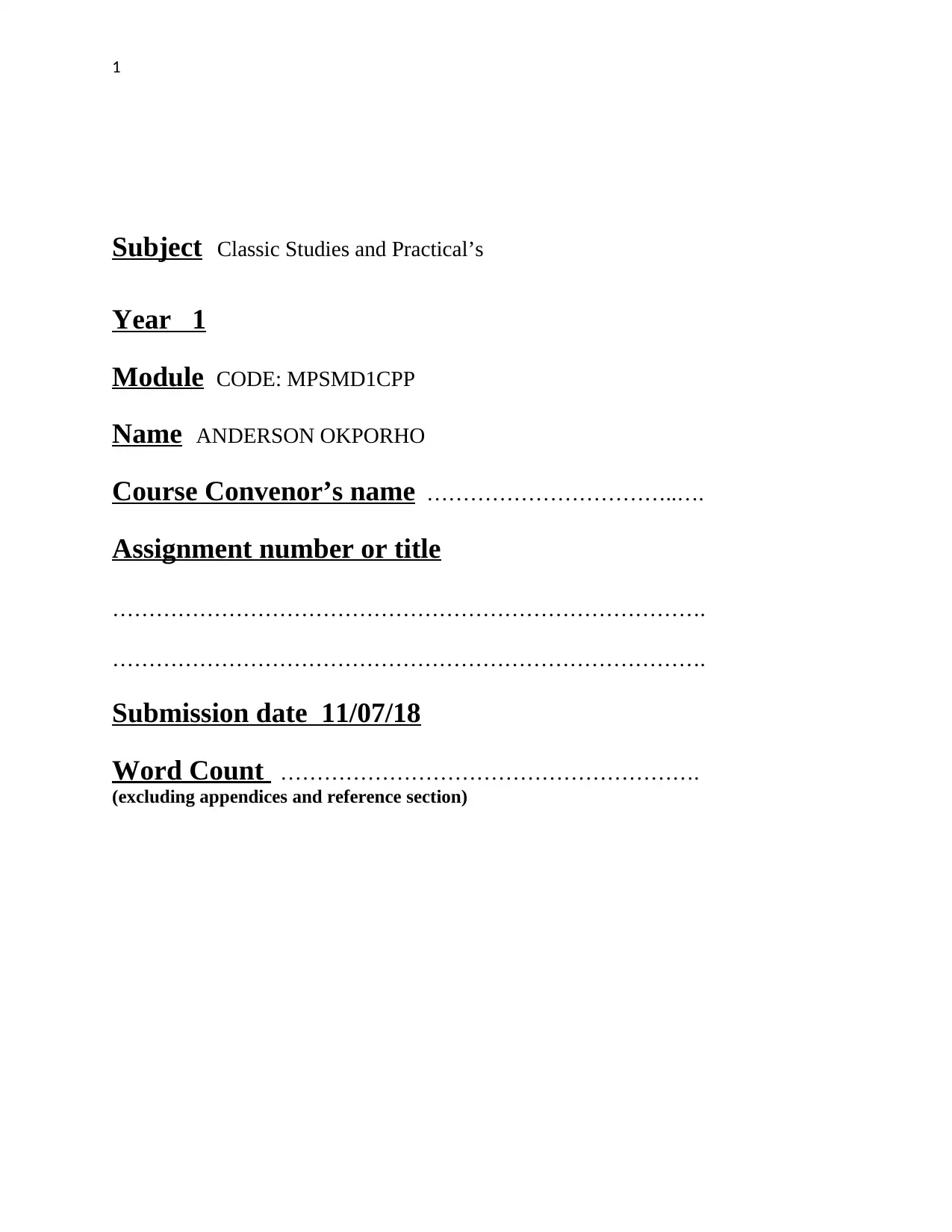
1
Subject Classic Studies and Practical’s
Year 1
Module CODE: MPSMD1CPP
Name ANDERSON OKPORHO
Course Convenor’s name ……………………………..….
Assignment number or title
……………………………………………………………………….
……………………………………………………………………….
Submission date 11/07/18
Word Count ………………………………………………….
(excluding appendices and reference section)
Subject Classic Studies and Practical’s
Year 1
Module CODE: MPSMD1CPP
Name ANDERSON OKPORHO
Course Convenor’s name ……………………………..….
Assignment number or title
……………………………………………………………………….
……………………………………………………………………….
Submission date 11/07/18
Word Count ………………………………………………….
(excluding appendices and reference section)
Paraphrase This Document
Need a fresh take? Get an instant paraphrase of this document with our AI Paraphraser
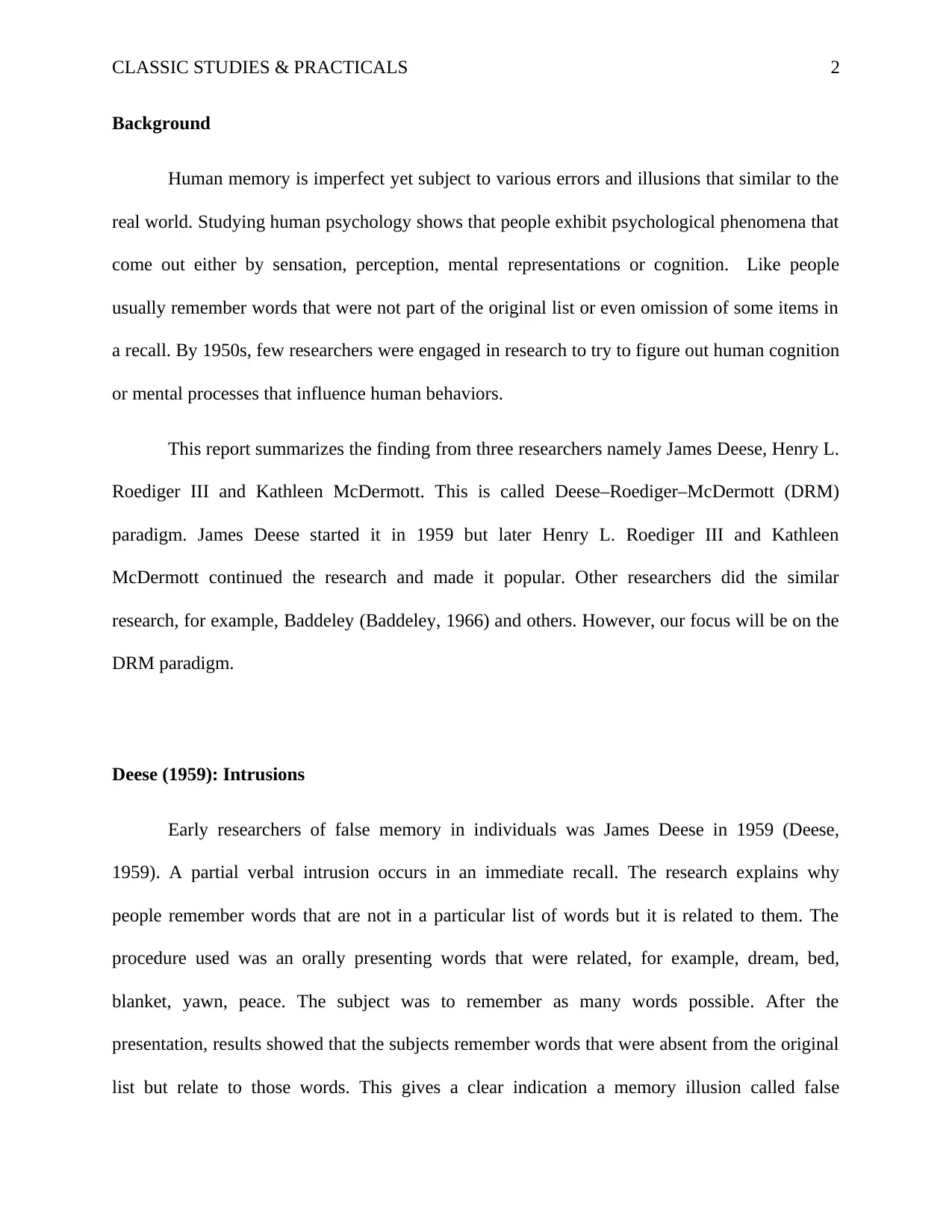
CLASSIC STUDIES & PRACTICALS 2
Background
Human memory is imperfect yet subject to various errors and illusions that similar to the
real world. Studying human psychology shows that people exhibit psychological phenomena that
come out either by sensation, perception, mental representations or cognition. Like people
usually remember words that were not part of the original list or even omission of some items in
a recall. By 1950s, few researchers were engaged in research to try to figure out human cognition
or mental processes that influence human behaviors.
This report summarizes the finding from three researchers namely James Deese, Henry L.
Roediger III and Kathleen McDermott. This is called Deese–Roediger–McDermott (DRM)
paradigm. James Deese started it in 1959 but later Henry L. Roediger III and Kathleen
McDermott continued the research and made it popular. Other researchers did the similar
research, for example, Baddeley (Baddeley, 1966) and others. However, our focus will be on the
DRM paradigm.
Deese (1959): Intrusions
Early researchers of false memory in individuals was James Deese in 1959 (Deese,
1959). A partial verbal intrusion occurs in an immediate recall. The research explains why
people remember words that are not in a particular list of words but it is related to them. The
procedure used was an orally presenting words that were related, for example, dream, bed,
blanket, yawn, peace. The subject was to remember as many words possible. After the
presentation, results showed that the subjects remember words that were absent from the original
list but relate to those words. This gives a clear indication a memory illusion called false
Background
Human memory is imperfect yet subject to various errors and illusions that similar to the
real world. Studying human psychology shows that people exhibit psychological phenomena that
come out either by sensation, perception, mental representations or cognition. Like people
usually remember words that were not part of the original list or even omission of some items in
a recall. By 1950s, few researchers were engaged in research to try to figure out human cognition
or mental processes that influence human behaviors.
This report summarizes the finding from three researchers namely James Deese, Henry L.
Roediger III and Kathleen McDermott. This is called Deese–Roediger–McDermott (DRM)
paradigm. James Deese started it in 1959 but later Henry L. Roediger III and Kathleen
McDermott continued the research and made it popular. Other researchers did the similar
research, for example, Baddeley (Baddeley, 1966) and others. However, our focus will be on the
DRM paradigm.
Deese (1959): Intrusions
Early researchers of false memory in individuals was James Deese in 1959 (Deese,
1959). A partial verbal intrusion occurs in an immediate recall. The research explains why
people remember words that are not in a particular list of words but it is related to them. The
procedure used was an orally presenting words that were related, for example, dream, bed,
blanket, yawn, peace. The subject was to remember as many words possible. After the
presentation, results showed that the subjects remember words that were absent from the original
list but relate to those words. This gives a clear indication a memory illusion called false
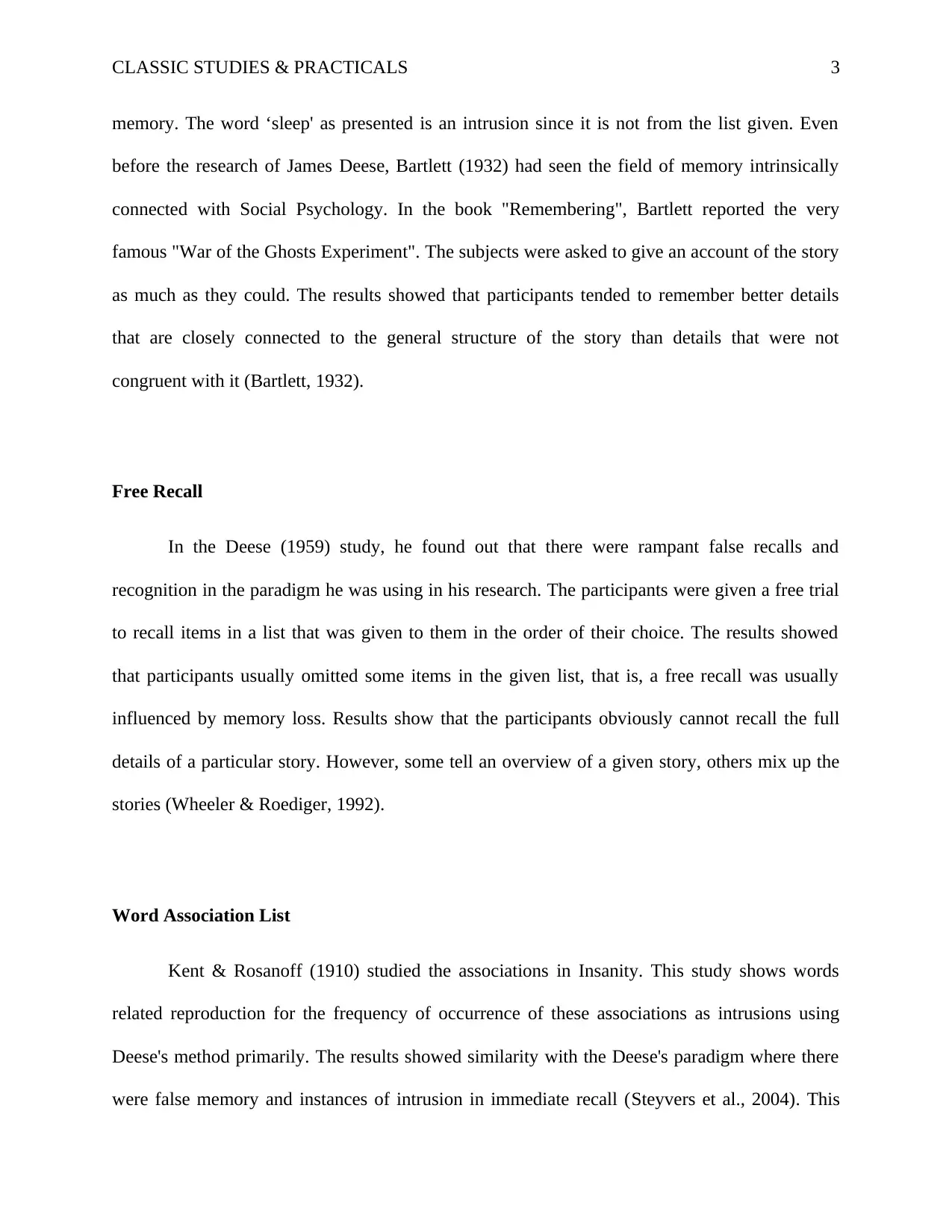
CLASSIC STUDIES & PRACTICALS 3
memory. The word ‘sleep' as presented is an intrusion since it is not from the list given. Even
before the research of James Deese, Bartlett (1932) had seen the field of memory intrinsically
connected with Social Psychology. In the book "Remembering", Bartlett reported the very
famous "War of the Ghosts Experiment". The subjects were asked to give an account of the story
as much as they could. The results showed that participants tended to remember better details
that are closely connected to the general structure of the story than details that were not
congruent with it (Bartlett, 1932).
Free Recall
In the Deese (1959) study, he found out that there were rampant false recalls and
recognition in the paradigm he was using in his research. The participants were given a free trial
to recall items in a list that was given to them in the order of their choice. The results showed
that participants usually omitted some items in the given list, that is, a free recall was usually
influenced by memory loss. Results show that the participants obviously cannot recall the full
details of a particular story. However, some tell an overview of a given story, others mix up the
stories (Wheeler & Roediger, 1992).
Word Association List
Kent & Rosanoff (1910) studied the associations in Insanity. This study shows words
related reproduction for the frequency of occurrence of these associations as intrusions using
Deese's method primarily. The results showed similarity with the Deese's paradigm where there
were false memory and instances of intrusion in immediate recall (Steyvers et al., 2004). This
memory. The word ‘sleep' as presented is an intrusion since it is not from the list given. Even
before the research of James Deese, Bartlett (1932) had seen the field of memory intrinsically
connected with Social Psychology. In the book "Remembering", Bartlett reported the very
famous "War of the Ghosts Experiment". The subjects were asked to give an account of the story
as much as they could. The results showed that participants tended to remember better details
that are closely connected to the general structure of the story than details that were not
congruent with it (Bartlett, 1932).
Free Recall
In the Deese (1959) study, he found out that there were rampant false recalls and
recognition in the paradigm he was using in his research. The participants were given a free trial
to recall items in a list that was given to them in the order of their choice. The results showed
that participants usually omitted some items in the given list, that is, a free recall was usually
influenced by memory loss. Results show that the participants obviously cannot recall the full
details of a particular story. However, some tell an overview of a given story, others mix up the
stories (Wheeler & Roediger, 1992).
Word Association List
Kent & Rosanoff (1910) studied the associations in Insanity. This study shows words
related reproduction for the frequency of occurrence of these associations as intrusions using
Deese's method primarily. The results showed similarity with the Deese's paradigm where there
were false memory and instances of intrusion in immediate recall (Steyvers et al., 2004). This
⊘ This is a preview!⊘
Do you want full access?
Subscribe today to unlock all pages.

Trusted by 1+ million students worldwide
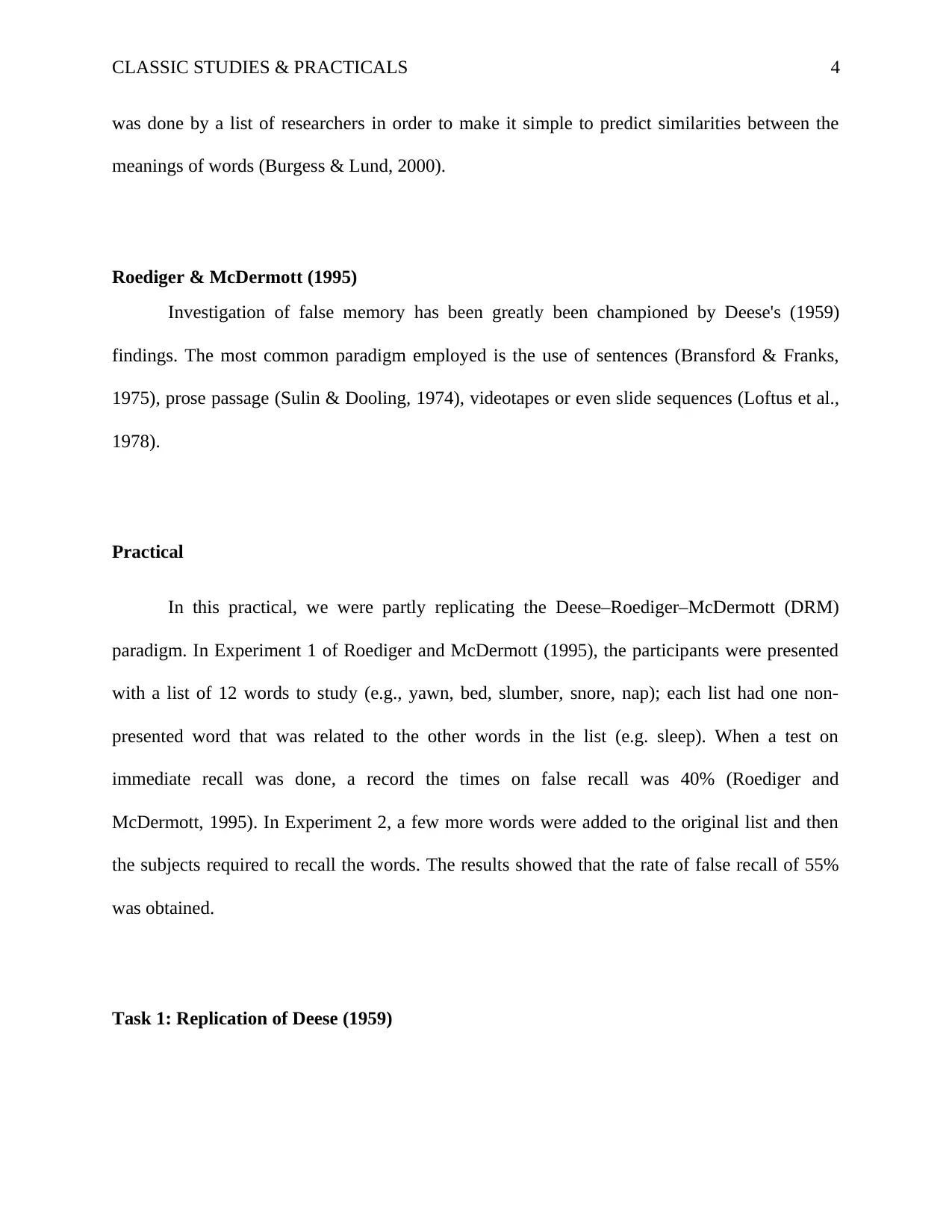
CLASSIC STUDIES & PRACTICALS 4
was done by a list of researchers in order to make it simple to predict similarities between the
meanings of words (Burgess & Lund, 2000).
Roediger & McDermott (1995)
Investigation of false memory has been greatly been championed by Deese's (1959)
findings. The most common paradigm employed is the use of sentences (Bransford & Franks,
1975), prose passage (Sulin & Dooling, 1974), videotapes or even slide sequences (Loftus et al.,
1978).
Practical
In this practical, we were partly replicating the Deese–Roediger–McDermott (DRM)
paradigm. In Experiment 1 of Roediger and McDermott (1995), the participants were presented
with a list of 12 words to study (e.g., yawn, bed, slumber, snore, nap); each list had one non-
presented word that was related to the other words in the list (e.g. sleep). When a test on
immediate recall was done, a record the times on false recall was 40% (Roediger and
McDermott, 1995). In Experiment 2, a few more words were added to the original list and then
the subjects required to recall the words. The results showed that the rate of false recall of 55%
was obtained.
Task 1: Replication of Deese (1959)
was done by a list of researchers in order to make it simple to predict similarities between the
meanings of words (Burgess & Lund, 2000).
Roediger & McDermott (1995)
Investigation of false memory has been greatly been championed by Deese's (1959)
findings. The most common paradigm employed is the use of sentences (Bransford & Franks,
1975), prose passage (Sulin & Dooling, 1974), videotapes or even slide sequences (Loftus et al.,
1978).
Practical
In this practical, we were partly replicating the Deese–Roediger–McDermott (DRM)
paradigm. In Experiment 1 of Roediger and McDermott (1995), the participants were presented
with a list of 12 words to study (e.g., yawn, bed, slumber, snore, nap); each list had one non-
presented word that was related to the other words in the list (e.g. sleep). When a test on
immediate recall was done, a record the times on false recall was 40% (Roediger and
McDermott, 1995). In Experiment 2, a few more words were added to the original list and then
the subjects required to recall the words. The results showed that the rate of false recall of 55%
was obtained.
Task 1: Replication of Deese (1959)
Paraphrase This Document
Need a fresh take? Get an instant paraphrase of this document with our AI Paraphraser
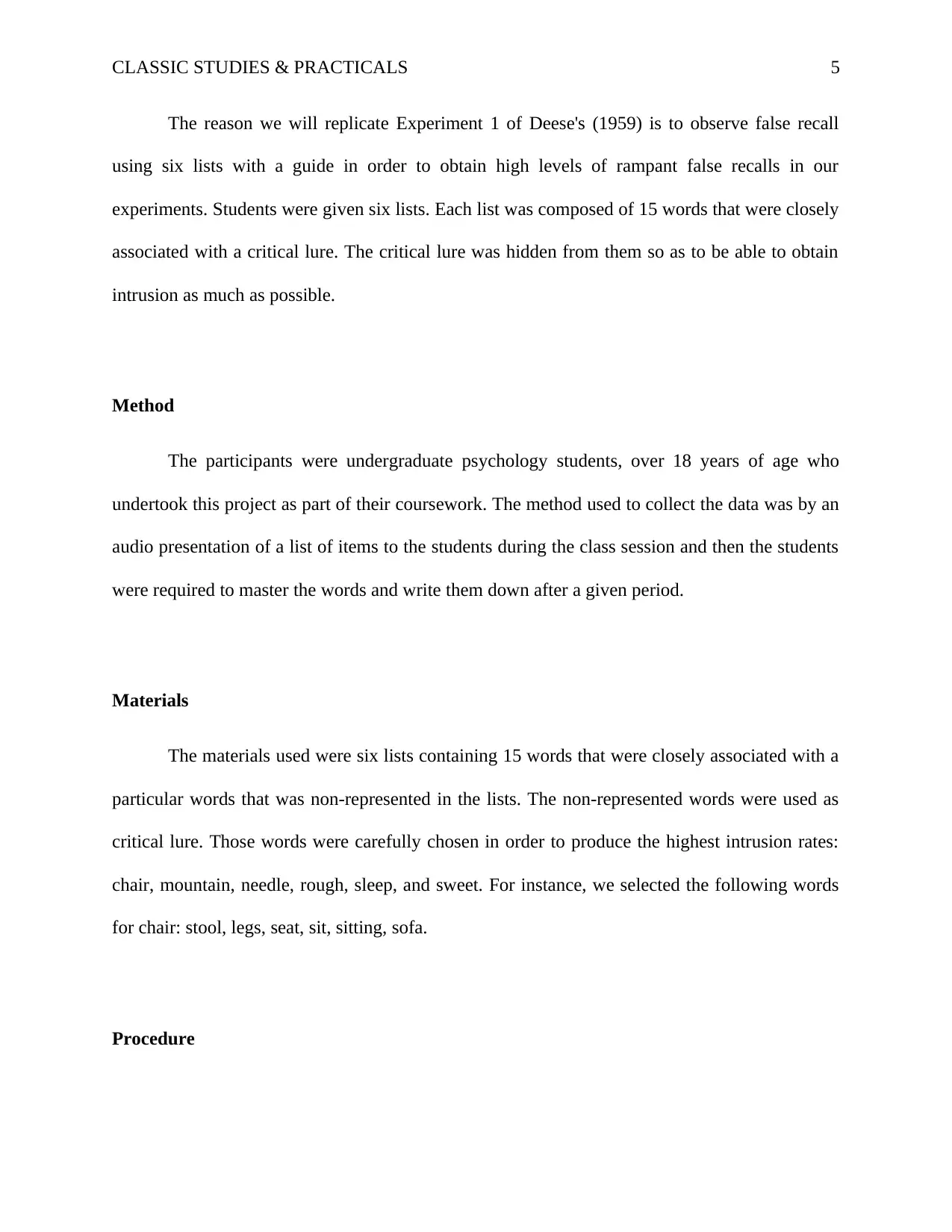
CLASSIC STUDIES & PRACTICALS 5
The reason we will replicate Experiment 1 of Deese's (1959) is to observe false recall
using six lists with a guide in order to obtain high levels of rampant false recalls in our
experiments. Students were given six lists. Each list was composed of 15 words that were closely
associated with a critical lure. The critical lure was hidden from them so as to be able to obtain
intrusion as much as possible.
Method
The participants were undergraduate psychology students, over 18 years of age who
undertook this project as part of their coursework. The method used to collect the data was by an
audio presentation of a list of items to the students during the class session and then the students
were required to master the words and write them down after a given period.
Materials
The materials used were six lists containing 15 words that were closely associated with a
particular words that was non-represented in the lists. The non-represented words were used as
critical lure. Those words were carefully chosen in order to produce the highest intrusion rates:
chair, mountain, needle, rough, sleep, and sweet. For instance, we selected the following words
for chair: stool, legs, seat, sit, sitting, sofa.
Procedure
The reason we will replicate Experiment 1 of Deese's (1959) is to observe false recall
using six lists with a guide in order to obtain high levels of rampant false recalls in our
experiments. Students were given six lists. Each list was composed of 15 words that were closely
associated with a critical lure. The critical lure was hidden from them so as to be able to obtain
intrusion as much as possible.
Method
The participants were undergraduate psychology students, over 18 years of age who
undertook this project as part of their coursework. The method used to collect the data was by an
audio presentation of a list of items to the students during the class session and then the students
were required to master the words and write them down after a given period.
Materials
The materials used were six lists containing 15 words that were closely associated with a
particular words that was non-represented in the lists. The non-represented words were used as
critical lure. Those words were carefully chosen in order to produce the highest intrusion rates:
chair, mountain, needle, rough, sleep, and sweet. For instance, we selected the following words
for chair: stool, legs, seat, sit, sitting, sofa.
Procedure
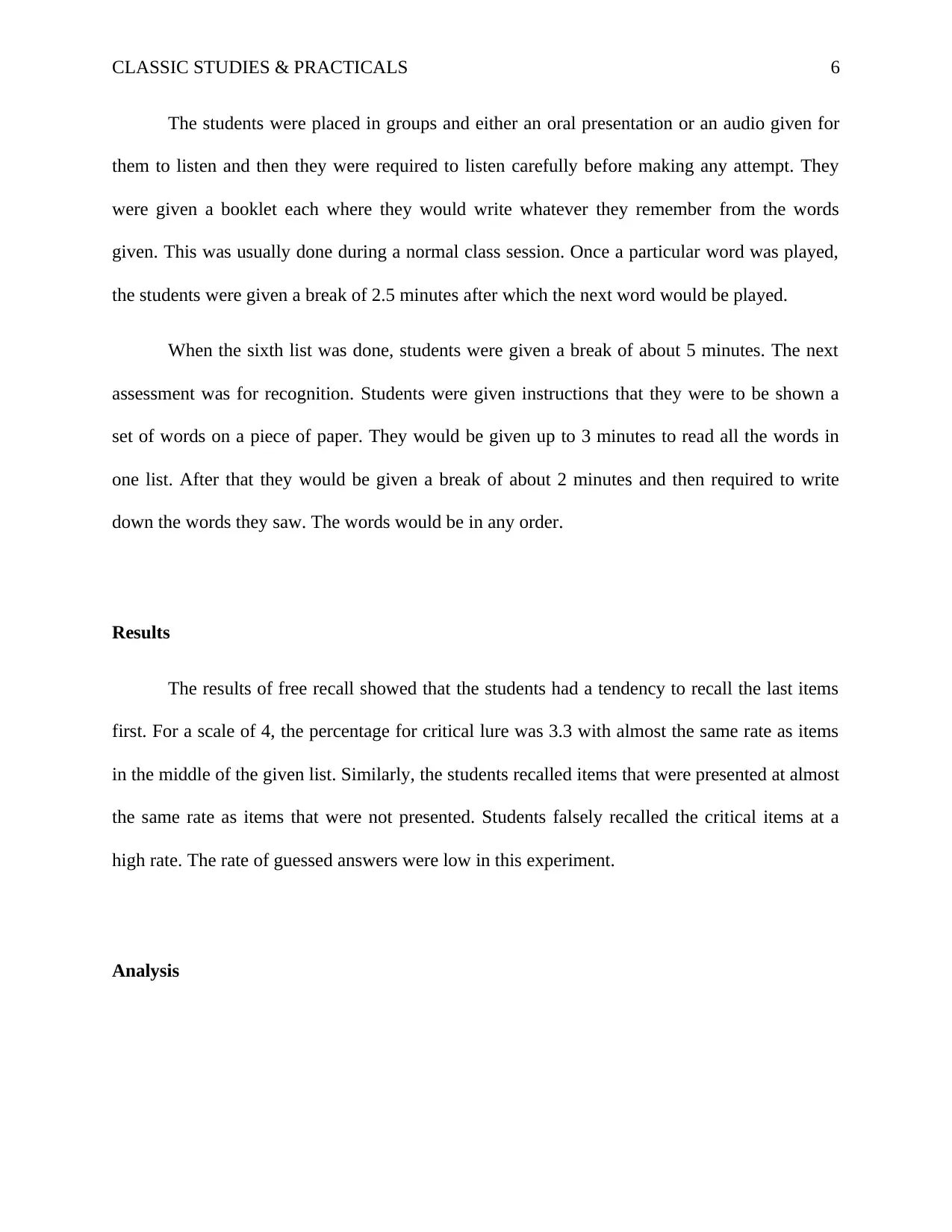
CLASSIC STUDIES & PRACTICALS 6
The students were placed in groups and either an oral presentation or an audio given for
them to listen and then they were required to listen carefully before making any attempt. They
were given a booklet each where they would write whatever they remember from the words
given. This was usually done during a normal class session. Once a particular word was played,
the students were given a break of 2.5 minutes after which the next word would be played.
When the sixth list was done, students were given a break of about 5 minutes. The next
assessment was for recognition. Students were given instructions that they were to be shown a
set of words on a piece of paper. They would be given up to 3 minutes to read all the words in
one list. After that they would be given a break of about 2 minutes and then required to write
down the words they saw. The words would be in any order.
Results
The results of free recall showed that the students had a tendency to recall the last items
first. For a scale of 4, the percentage for critical lure was 3.3 with almost the same rate as items
in the middle of the given list. Similarly, the students recalled items that were presented at almost
the same rate as items that were not presented. Students falsely recalled the critical items at a
high rate. The rate of guessed answers were low in this experiment.
Analysis
The students were placed in groups and either an oral presentation or an audio given for
them to listen and then they were required to listen carefully before making any attempt. They
were given a booklet each where they would write whatever they remember from the words
given. This was usually done during a normal class session. Once a particular word was played,
the students were given a break of 2.5 minutes after which the next word would be played.
When the sixth list was done, students were given a break of about 5 minutes. The next
assessment was for recognition. Students were given instructions that they were to be shown a
set of words on a piece of paper. They would be given up to 3 minutes to read all the words in
one list. After that they would be given a break of about 2 minutes and then required to write
down the words they saw. The words would be in any order.
Results
The results of free recall showed that the students had a tendency to recall the last items
first. For a scale of 4, the percentage for critical lure was 3.3 with almost the same rate as items
in the middle of the given list. Similarly, the students recalled items that were presented at almost
the same rate as items that were not presented. Students falsely recalled the critical items at a
high rate. The rate of guessed answers were low in this experiment.
Analysis
⊘ This is a preview!⊘
Do you want full access?
Subscribe today to unlock all pages.

Trusted by 1+ million students worldwide
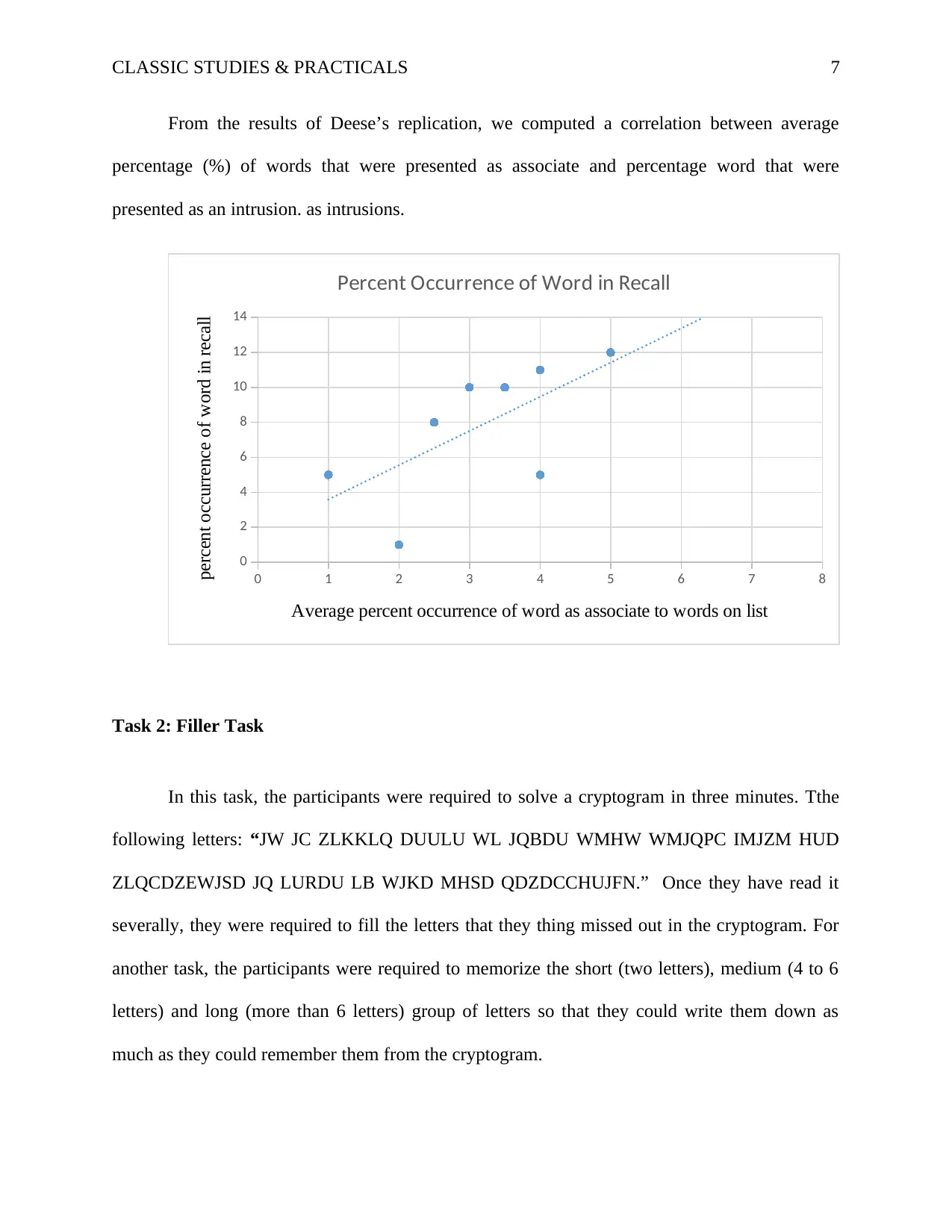
CLASSIC STUDIES & PRACTICALS 7
From the results of Deese’s replication, we computed a correlation between average
percentage (%) of words that were presented as associate and percentage word that were
presented as an intrusion. as intrusions.
0 1 2 3 4 5 6 7 8
0
2
4
6
8
10
12
14
Percent Occurrence of Word in Recall
Average percent occurrence of word as associate to words on list
percent occurrence of word in recall
Task 2: Filler Task
In this task, the participants were required to solve a cryptogram in three minutes. Tthe
following letters: “JW JC ZLKKLQ DUULU WL JQBDU WMHW WMJQPC IMJZM HUD
ZLQCDZEWJSD JQ LURDU LB WJKD MHSD QDZDCCHUJFN.” Once they have read it
severally, they were required to fill the letters that they thing missed out in the cryptogram. For
another task, the participants were required to memorize the short (two letters), medium (4 to 6
letters) and long (more than 6 letters) group of letters so that they could write them down as
much as they could remember them from the cryptogram.
From the results of Deese’s replication, we computed a correlation between average
percentage (%) of words that were presented as associate and percentage word that were
presented as an intrusion. as intrusions.
0 1 2 3 4 5 6 7 8
0
2
4
6
8
10
12
14
Percent Occurrence of Word in Recall
Average percent occurrence of word as associate to words on list
percent occurrence of word in recall
Task 2: Filler Task
In this task, the participants were required to solve a cryptogram in three minutes. Tthe
following letters: “JW JC ZLKKLQ DUULU WL JQBDU WMHW WMJQPC IMJZM HUD
ZLQCDZEWJSD JQ LURDU LB WJKD MHSD QDZDCCHUJFN.” Once they have read it
severally, they were required to fill the letters that they thing missed out in the cryptogram. For
another task, the participants were required to memorize the short (two letters), medium (4 to 6
letters) and long (more than 6 letters) group of letters so that they could write them down as
much as they could remember them from the cryptogram.
Paraphrase This Document
Need a fresh take? Get an instant paraphrase of this document with our AI Paraphraser
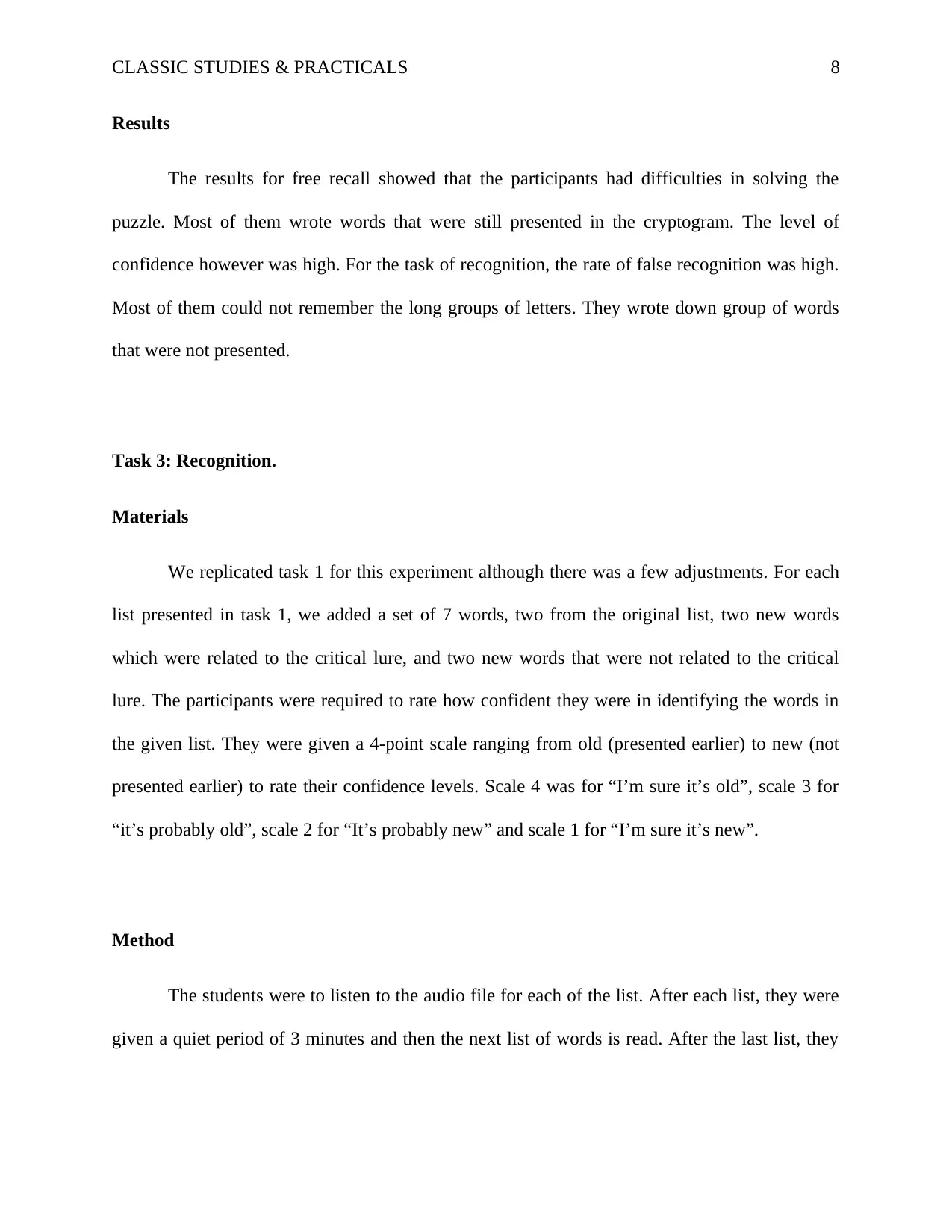
CLASSIC STUDIES & PRACTICALS 8
Results
The results for free recall showed that the participants had difficulties in solving the
puzzle. Most of them wrote words that were still presented in the cryptogram. The level of
confidence however was high. For the task of recognition, the rate of false recognition was high.
Most of them could not remember the long groups of letters. They wrote down group of words
that were not presented.
Task 3: Recognition.
Materials
We replicated task 1 for this experiment although there was a few adjustments. For each
list presented in task 1, we added a set of 7 words, two from the original list, two new words
which were related to the critical lure, and two new words that were not related to the critical
lure. The participants were required to rate how confident they were in identifying the words in
the given list. They were given a 4-point scale ranging from old (presented earlier) to new (not
presented earlier) to rate their confidence levels. Scale 4 was for “I’m sure it’s old”, scale 3 for
“it’s probably old”, scale 2 for “It’s probably new” and scale 1 for “I’m sure it’s new”.
Method
The students were to listen to the audio file for each of the list. After each list, they were
given a quiet period of 3 minutes and then the next list of words is read. After the last list, they
Results
The results for free recall showed that the participants had difficulties in solving the
puzzle. Most of them wrote words that were still presented in the cryptogram. The level of
confidence however was high. For the task of recognition, the rate of false recognition was high.
Most of them could not remember the long groups of letters. They wrote down group of words
that were not presented.
Task 3: Recognition.
Materials
We replicated task 1 for this experiment although there was a few adjustments. For each
list presented in task 1, we added a set of 7 words, two from the original list, two new words
which were related to the critical lure, and two new words that were not related to the critical
lure. The participants were required to rate how confident they were in identifying the words in
the given list. They were given a 4-point scale ranging from old (presented earlier) to new (not
presented earlier) to rate their confidence levels. Scale 4 was for “I’m sure it’s old”, scale 3 for
“it’s probably old”, scale 2 for “It’s probably new” and scale 1 for “I’m sure it’s new”.
Method
The students were to listen to the audio file for each of the list. After each list, they were
given a quiet period of 3 minutes and then the next list of words is read. After the last list, they
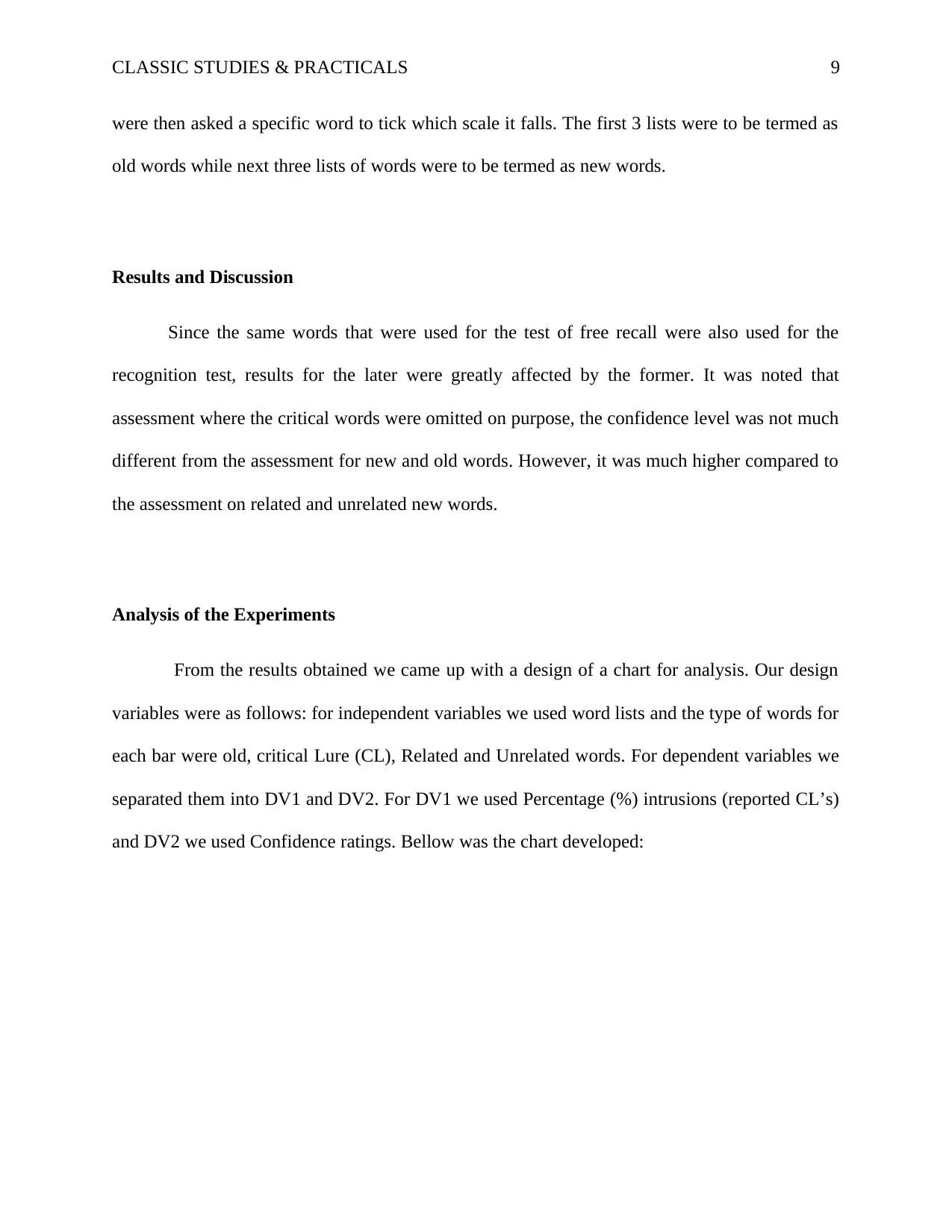
CLASSIC STUDIES & PRACTICALS 9
were then asked a specific word to tick which scale it falls. The first 3 lists were to be termed as
old words while next three lists of words were to be termed as new words.
Results and Discussion
Since the same words that were used for the test of free recall were also used for the
recognition test, results for the later were greatly affected by the former. It was noted that
assessment where the critical words were omitted on purpose, the confidence level was not much
different from the assessment for new and old words. However, it was much higher compared to
the assessment on related and unrelated new words.
Analysis of the Experiments
From the results obtained we came up with a design of a chart for analysis. Our design
variables were as follows: for independent variables we used word lists and the type of words for
each bar were old, critical Lure (CL), Related and Unrelated words. For dependent variables we
separated them into DV1 and DV2. For DV1 we used Percentage (%) intrusions (reported CL’s)
and DV2 we used Confidence ratings. Bellow was the chart developed:
were then asked a specific word to tick which scale it falls. The first 3 lists were to be termed as
old words while next three lists of words were to be termed as new words.
Results and Discussion
Since the same words that were used for the test of free recall were also used for the
recognition test, results for the later were greatly affected by the former. It was noted that
assessment where the critical words were omitted on purpose, the confidence level was not much
different from the assessment for new and old words. However, it was much higher compared to
the assessment on related and unrelated new words.
Analysis of the Experiments
From the results obtained we came up with a design of a chart for analysis. Our design
variables were as follows: for independent variables we used word lists and the type of words for
each bar were old, critical Lure (CL), Related and Unrelated words. For dependent variables we
separated them into DV1 and DV2. For DV1 we used Percentage (%) intrusions (reported CL’s)
and DV2 we used Confidence ratings. Bellow was the chart developed:
⊘ This is a preview!⊘
Do you want full access?
Subscribe today to unlock all pages.

Trusted by 1+ million students worldwide
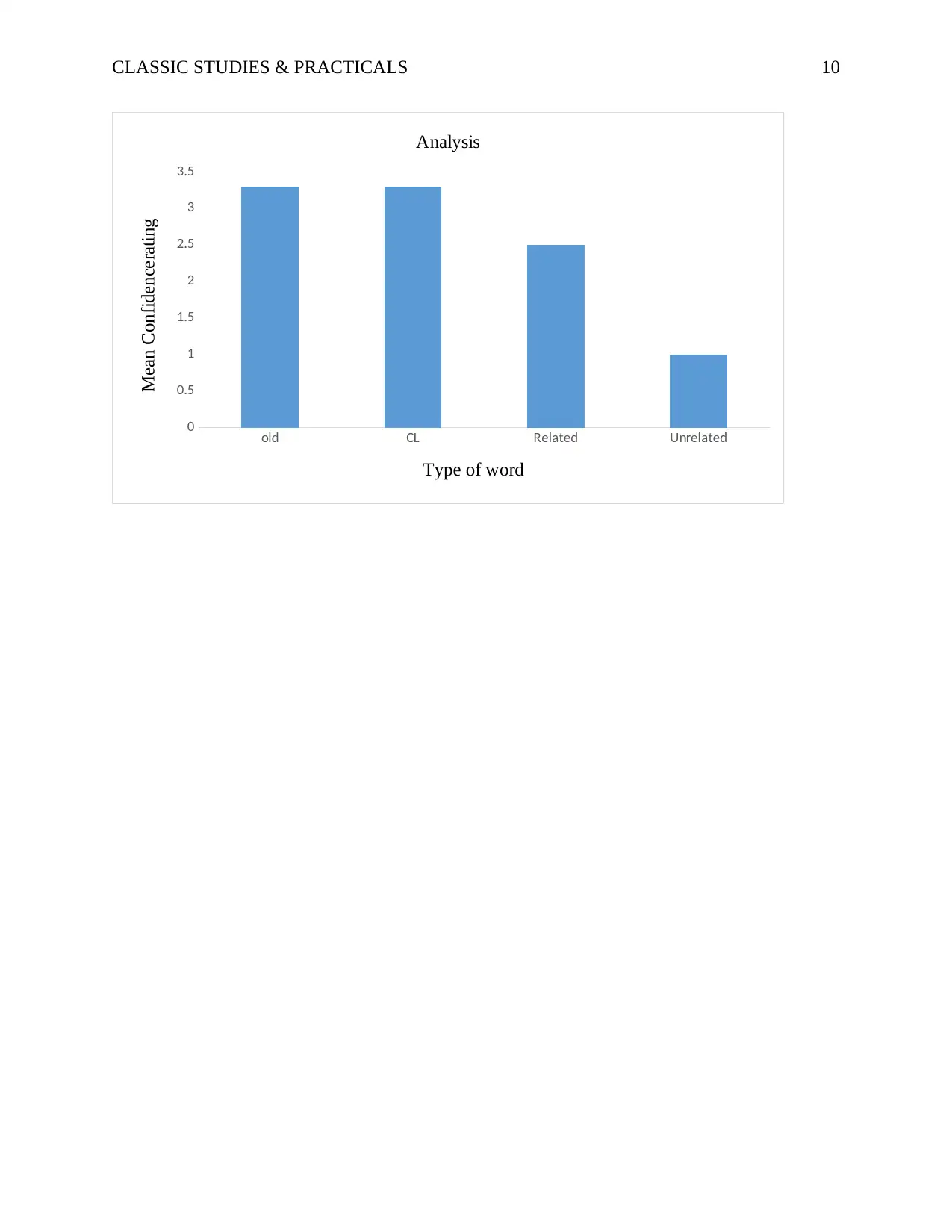
CLASSIC STUDIES & PRACTICALS 10
old CL Related Unrelated
0
0.5
1
1.5
2
2.5
3
3.5
Analysis
Type of word
Mean Confidencerating
old CL Related Unrelated
0
0.5
1
1.5
2
2.5
3
3.5
Analysis
Type of word
Mean Confidencerating
Paraphrase This Document
Need a fresh take? Get an instant paraphrase of this document with our AI Paraphraser
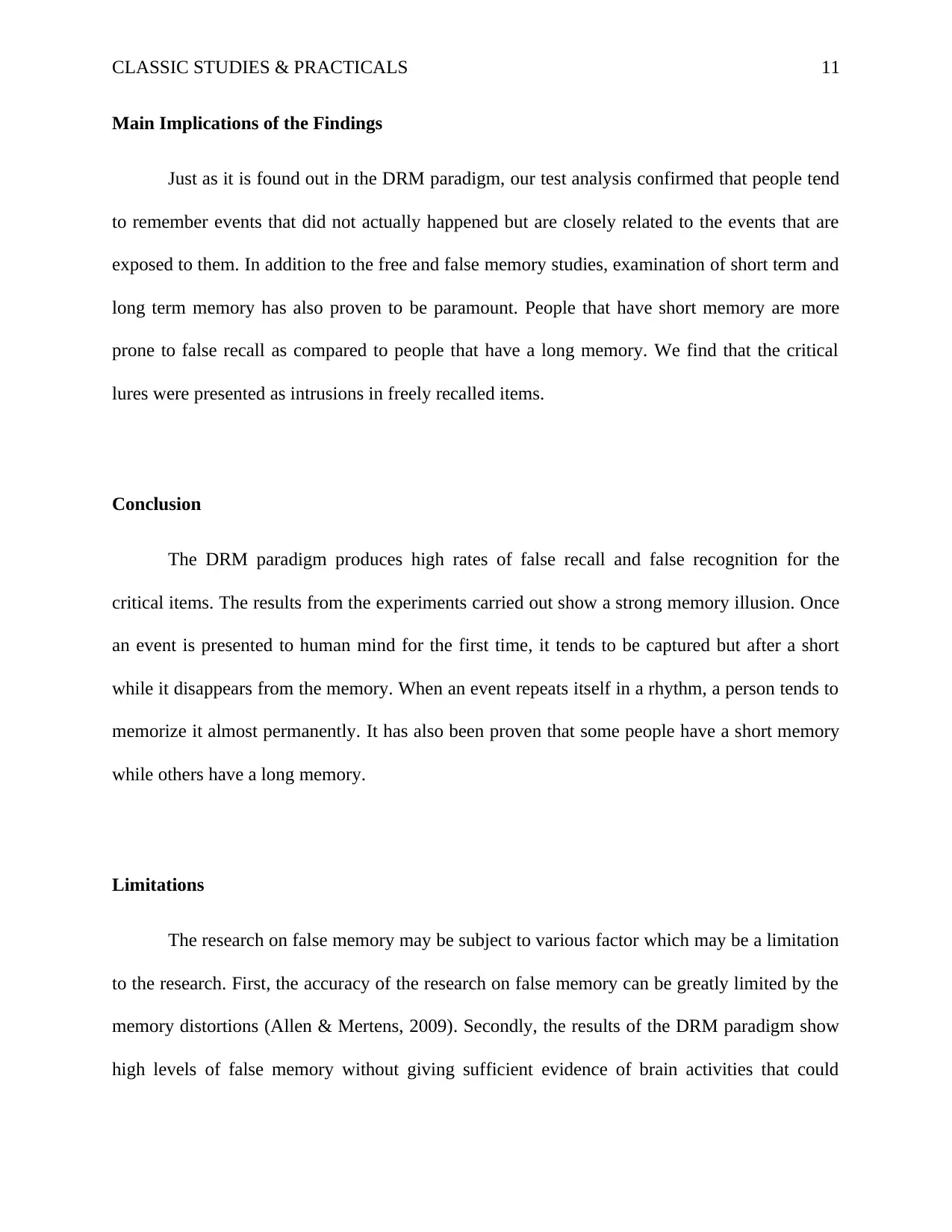
CLASSIC STUDIES & PRACTICALS 11
Main Implications of the Findings
Just as it is found out in the DRM paradigm, our test analysis confirmed that people tend
to remember events that did not actually happened but are closely related to the events that are
exposed to them. In addition to the free and false memory studies, examination of short term and
long term memory has also proven to be paramount. People that have short memory are more
prone to false recall as compared to people that have a long memory. We find that the critical
lures were presented as intrusions in freely recalled items.
Conclusion
The DRM paradigm produces high rates of false recall and false recognition for the
critical items. The results from the experiments carried out show a strong memory illusion. Once
an event is presented to human mind for the first time, it tends to be captured but after a short
while it disappears from the memory. When an event repeats itself in a rhythm, a person tends to
memorize it almost permanently. It has also been proven that some people have a short memory
while others have a long memory.
Limitations
The research on false memory may be subject to various factor which may be a limitation
to the research. First, the accuracy of the research on false memory can be greatly limited by the
memory distortions (Allen & Mertens, 2009). Secondly, the results of the DRM paradigm show
high levels of false memory without giving sufficient evidence of brain activities that could
Main Implications of the Findings
Just as it is found out in the DRM paradigm, our test analysis confirmed that people tend
to remember events that did not actually happened but are closely related to the events that are
exposed to them. In addition to the free and false memory studies, examination of short term and
long term memory has also proven to be paramount. People that have short memory are more
prone to false recall as compared to people that have a long memory. We find that the critical
lures were presented as intrusions in freely recalled items.
Conclusion
The DRM paradigm produces high rates of false recall and false recognition for the
critical items. The results from the experiments carried out show a strong memory illusion. Once
an event is presented to human mind for the first time, it tends to be captured but after a short
while it disappears from the memory. When an event repeats itself in a rhythm, a person tends to
memorize it almost permanently. It has also been proven that some people have a short memory
while others have a long memory.
Limitations
The research on false memory may be subject to various factor which may be a limitation
to the research. First, the accuracy of the research on false memory can be greatly limited by the
memory distortions (Allen & Mertens, 2009). Secondly, the results of the DRM paradigm show
high levels of false memory without giving sufficient evidence of brain activities that could
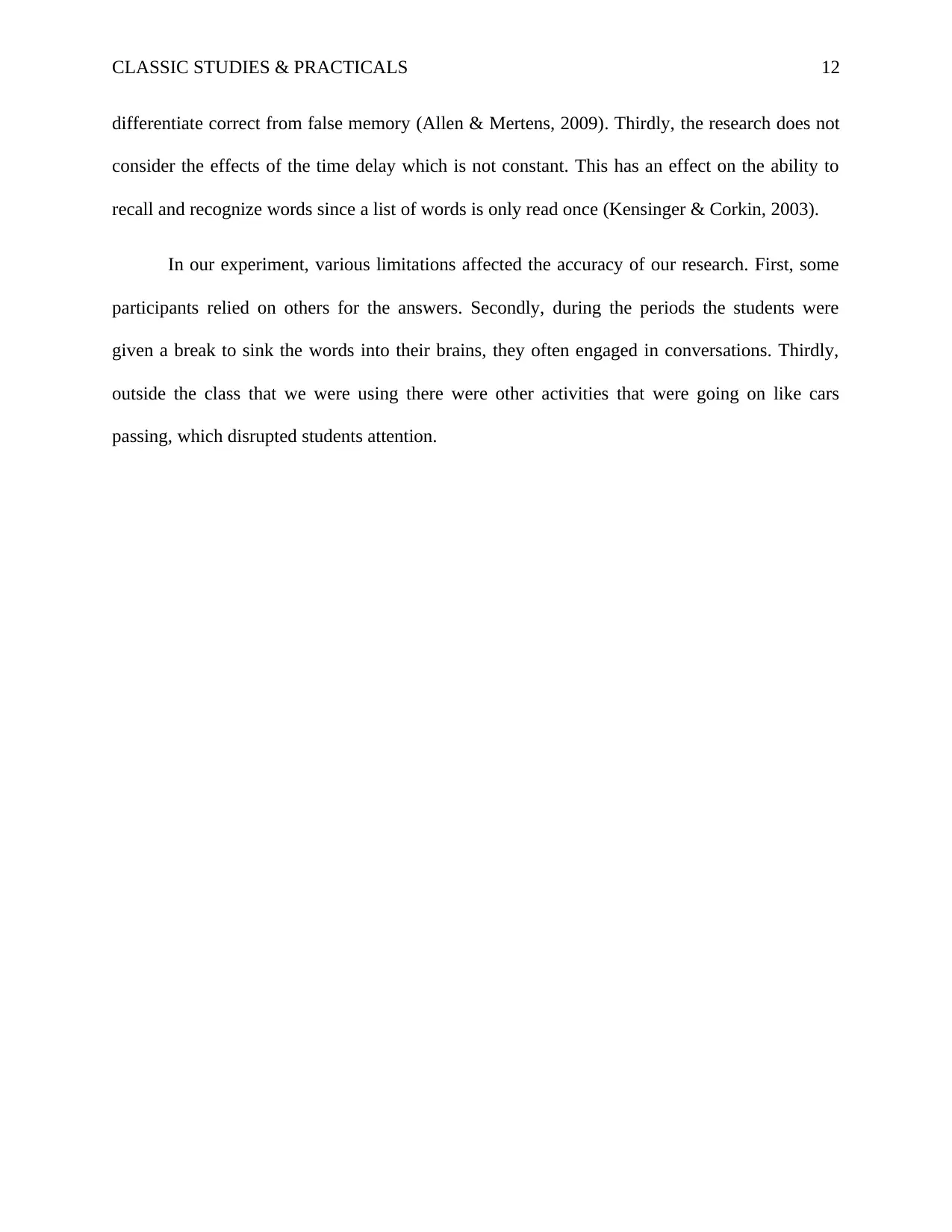
CLASSIC STUDIES & PRACTICALS 12
differentiate correct from false memory (Allen & Mertens, 2009). Thirdly, the research does not
consider the effects of the time delay which is not constant. This has an effect on the ability to
recall and recognize words since a list of words is only read once (Kensinger & Corkin, 2003).
In our experiment, various limitations affected the accuracy of our research. First, some
participants relied on others for the answers. Secondly, during the periods the students were
given a break to sink the words into their brains, they often engaged in conversations. Thirdly,
outside the class that we were using there were other activities that were going on like cars
passing, which disrupted students attention.
differentiate correct from false memory (Allen & Mertens, 2009). Thirdly, the research does not
consider the effects of the time delay which is not constant. This has an effect on the ability to
recall and recognize words since a list of words is only read once (Kensinger & Corkin, 2003).
In our experiment, various limitations affected the accuracy of our research. First, some
participants relied on others for the answers. Secondly, during the periods the students were
given a break to sink the words into their brains, they often engaged in conversations. Thirdly,
outside the class that we were using there were other activities that were going on like cars
passing, which disrupted students attention.
⊘ This is a preview!⊘
Do you want full access?
Subscribe today to unlock all pages.

Trusted by 1+ million students worldwide
1 out of 14
Related Documents
Your All-in-One AI-Powered Toolkit for Academic Success.
+13062052269
info@desklib.com
Available 24*7 on WhatsApp / Email
![[object Object]](/_next/static/media/star-bottom.7253800d.svg)
Unlock your academic potential
Copyright © 2020–2025 A2Z Services. All Rights Reserved. Developed and managed by ZUCOL.



